
Fritillaria imperialis, the crown imperial, imperial fritillary, Kaiser's crown, or Kurdish tulip is a species of flowering plant in the lily family Liliaceae, native to a wide stretch from the Anatolian plateau of Turkey, Iraq and Iran to Afghanistan, Pakistan, Northern India and the Himalayan foothills. It is also widely cultivated as an ornamental and reportedly naturalized in Austria, Sicily, and Washington State, USA. The common names and also the epithet "imperialis", literally "of the emperor", refer to the large circle of golden flowers, reminiscent of an emperor's crown.
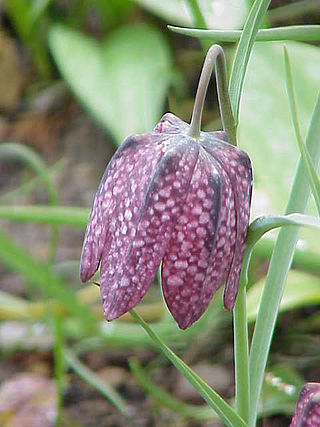
Fritillaria (fritillaries) is a genus of spring flowering herbaceous bulbous perennial plants in the lily family (Liliaceae). The type species, Fritillaria meleagris, was first described in Europe in 1571, while other species from the Middle East and Asia were also introduced to Europe at that time. The genus has about 130–140 species divided among eight subgenera. The flowers are usually solitary, nodding and bell-shaped with bulbs that have fleshy scales, resembling those of lilies. They are known for their large genome size and genetically are very closely related to lilies. They are native to the temperate regions of the Northern hemisphere, from the Mediterranean and North Africa through Eurasia and southwest Asia to western North America. Many are endangered due to enthusiastic picking.

Gagea is a large genus of spring flowers in the lily family. It is found primarily in Eurasia with a few species extending into North Africa and one species in North America.

Allium giganteum, common name giant onion or giant leek, is an Asian species of onion, native to central and southwestern Asia but cultivated in many countries as a flowering garden plant. It is the tallest species of Allium in common cultivation, growing to 1.5 metres (4.9 ft).
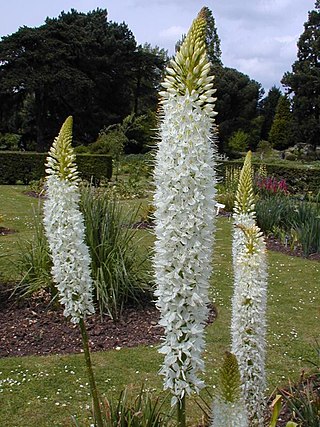
Eremurus is a genus of deciduous perennial flowers in the family Asphodelaceae. They are also known as the foxtail lilies or desert candles. They are native to eastern Europe in, and temperate Asia from Turkey to China, with many species in Central Asia.

Notholirion is a small Asian genus of bulbous plants in the lily family, Liliaceae. It is closely related to Lilium, but each individual flowers only once, and then dies after producing offsets. The bulb is covered by a tunic. Leaves are basal, produced in autumn and winter.
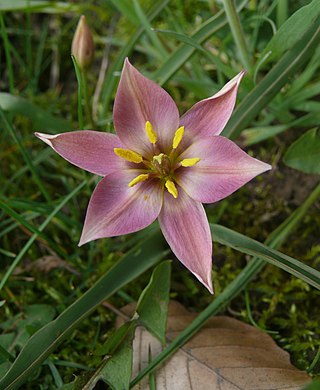
Tulipa humilis is a species of flowering plant in the lily family, found in Syria, Lebanon, Palestine, Turkey, Iran, and the North Caucasus region of Russia. The flowers are pink with yellow centers. Its preferred habitat are rocky mountain slopes. It is known by several other names in horticulture.
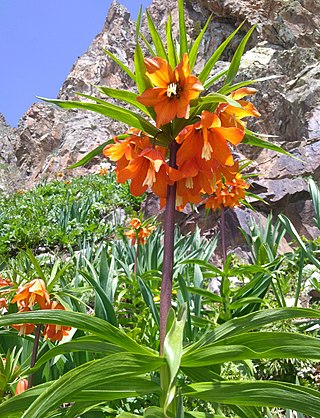
Fritillaria eduardii is a species of flowering plant in the family Liliaceae, native to Central Asia. It is closely related to the widely cultivated species, F. imperialis, called "crown imperial."
Fritillaria chitralensis is a species of flowering plant in the lily family Liliaceae, native to Afghanistan and the Chitral District of northern Pakistan.
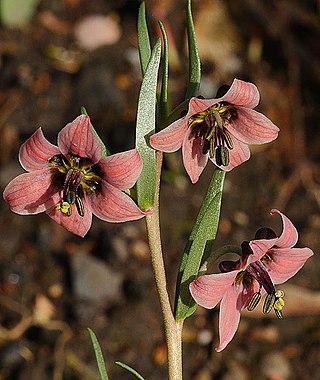
Fritillaria karelinii is an Asian species of herbaceous perennial plant in the lily family Liliaceae, native to Kazakhstan, Kyrgyzstan, Tajikistan, Uzbekistan, Turkmenistan, Iran, Pakistan, and Xinjiang.

Fritillaria gibbosa is a species of herbaceous perennial plant in the lily family Liliaceae. It is native to Afghanistan, Iran, Pakistan, Turkmenistan, and Transcaucasia.
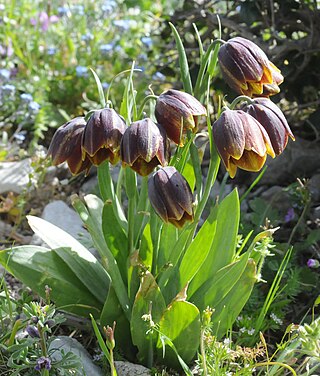
Fritillaria rhodocanakis is a species of plant in the lily family Liliaceae. In its pure form, it is found only on Hydra Island and on small neighboring islands in Greece. Additional populations occur in the Peloponnisos region of mainland Greece, though the specimens there show some degree of hybridization with F. spetsiotica and F. graeca. In 1987, some of the hybrids were described with the name Fritillaria rhodocanakis subsp. argolica, but this is now generally referred to as Fritillaria × spetsiotica Kamari.

The taxonomy of Tulipa places the genus in the family Liliaceae, and subdivides it as four subgenera, and comprises about 75 species.

Fritillaria assyriaca is a bulbous herbaceous perennial plant occurring in a region stretching from Turkey to Iran. It is a species in the genus Fritillaria, in the lily family Liliaceae. It is placed in the subgenus Fritillaria.
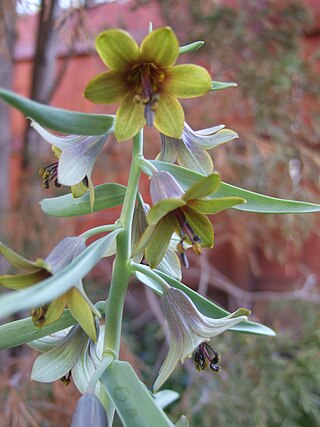
Fritillaria sewerzowii is a perennial herbaceous bulbous plant, distributed in alpine areas of central Asia. It is a species in the genus Fritillaria, in the lily family Liliaceae. It is placed in the subgenus Korolkowia.

Fritillaria dagana is a rare bulbous herbaceous perennial plant native to Siberia, Russia. It is a species in the genus Fritillaria of the family Liliaceae. It is placed in the subgenus Liliorhiza.

Fritillaria japonica is a perennial herbaceous bulbous plant, endemic to Japan. It is a species in the genus Fritillaria, in the family Liliaceae. It is placed in the subgenus Japonica.

Fritillaria reuteri is a perennial herbaceous bulbous plant, distributed in Turkey and Iran. It is a species in the genus Fritillaria, in the family Liliaceae. It is placed in the subgenus Fritillaria.
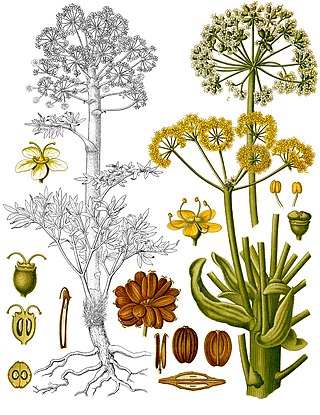
Ferula foetida is a species of Ferula native to Central Asia, Eastern Iran, western Afghanistan and western Pakistan. It is the most widely distributed species that produces asafoetida. It is often mistaken for the Southern Iranian species F. assa-foetida, for example, in Flora of the U.S.S.R. and Flora of Pakistan.


















